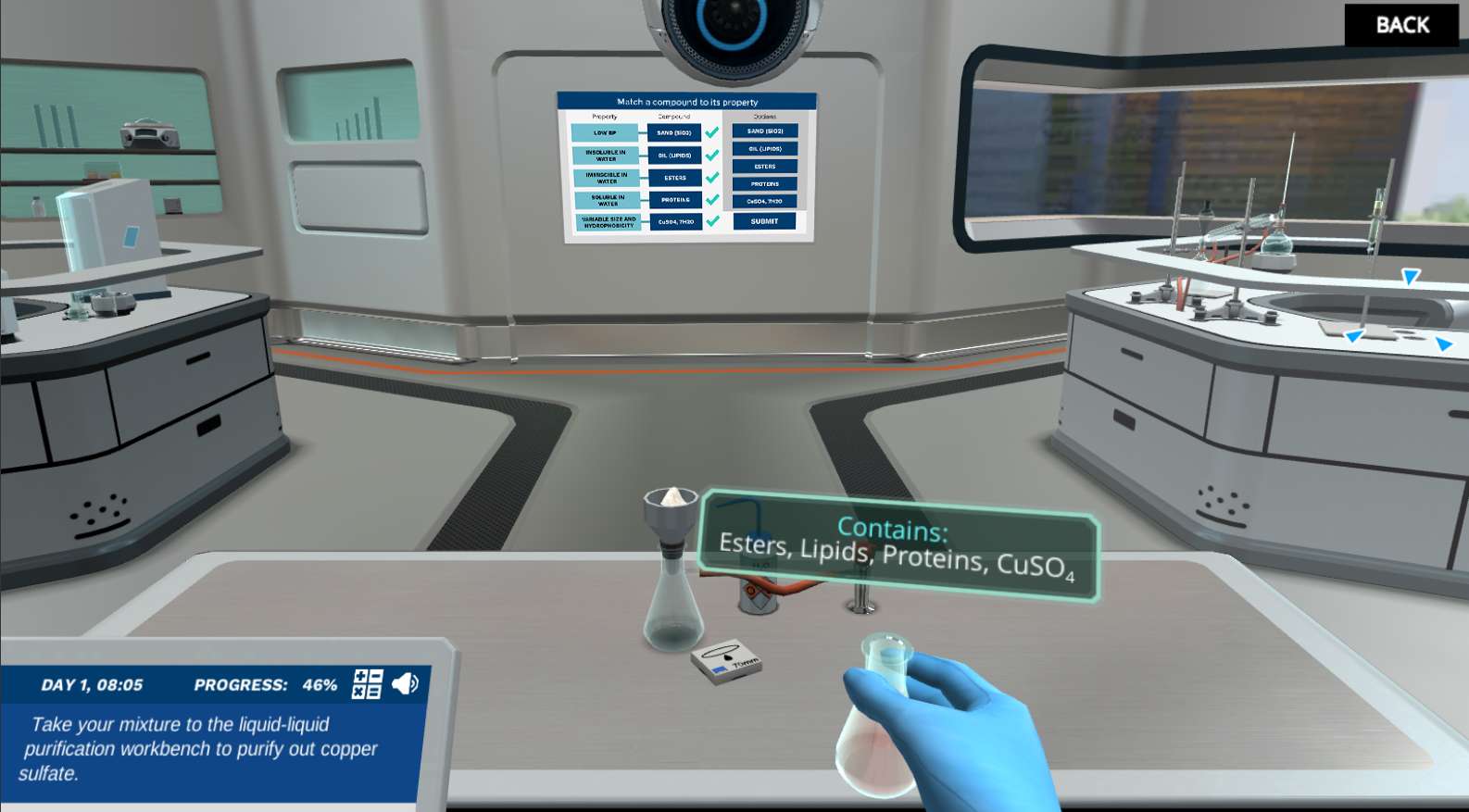Heading 1
Heading 2
Heading 3
Heading 4
Heading 5
Heading 6
Lorem ipsum dolor sit amet, consectetur adipiscing elit, sed do eiusmod tempor incididunt ut labore et dolore magna aliqua. Ut enim ad minim veniam, quis nostrud exercitation ullamco laboris nisi ut aliquip ex ea commodo consequat. Duis aute irure dolor in reprehenderit in voluptate velit esse cillum dolore eu fugiat nulla pariatur.
Block quote
Ordered list
- Item 1
- Item 2
- Item 3
Unordered list
- Item A
- Item B
- Item C
Bold text
Emphasis
Superscript
Subscript
About This Simulation
In this simulation, you will learn how to use a range of techniques to separate compounds from a mixture. Using their individual properties, develop and execute an experimental procedure to separate out each compound.
Learning Objectives
- Determine the best technique for recovering individual substances from a mixture
- Relate separation techniques back to the molecular properties they are used to discriminate between
About This Simulation
Lab Techniques
- Filtration
- Simple distillation
- Solvent extraction
- Size exclusion chromatography
- Electrolysis
- Electrolytic refining
- Recrystallization
- Zone refining
- Displacement
- Precipitation
Related Standards
- US College Year 1
- US College Year 2
- US College Year 3
Learn More About This Simulation
Do you have what it takes to be Labster’s top analytical chemist? In this simulation, you’ll use the property of a compound to match them to the relevant separation technique. Then, you’ll develop an experimental procedure, to purify the mixture like a pro!
Match compounds to their property Find out the contents of the mixture at the wall screen. Learn the definition of key terms such as solubility, miscibility, and hydrophobicity. Then, use your critical thinking skills to match both organic and inorganic compounds to the correct property.
Test your liquid purification skills Start by filtering your suspension to remove your solid. Recollect the mixture and go to the liquid-liquid purification bench for a real challenge. Try, fail, and try again in this open choice activity to purify your mixture using distillation, solvent extraction, and chromatography in the correct order.
Bonus property! Did you think we were done? Challenge your redox chemistry knowledge by deciding how to precipitate copper from copper sulfate solution. Place the zinc plate into your solution and watch your copper ions solidify and accumulate around the metal plate. Purify your solid Learn about common laboratory and state-of-the-art techniques used to purify copper: recrystallization, zone- and electrolytic refining. Be quizzed on the importance of choosing the right solvent for recrystallization. End the simulation by choosing the right combination of each technique to purify your copper solid.
For Science Programs Providing a Learning Advantage
Boost STEM Pass Rates
Boost Learning with Fun
75% of students show high engagement and improved grades with Labster
Discover Simulations That Match Your Syllabus
Easily bolster your learning objectives with relevant, interactive content
Place Students in the Shoes of Real Scientists
Practice a lab procedure or visualize theory through narrative-driven scenarios


FAQs
Find answers to frequently asked questions.
Heading 1
Heading 2
Heading 3
Heading 4
Heading 5
Heading 6
Lorem ipsum dolor sit amet, consectetur adipiscing elit, sed do eiusmod tempor incididunt ut labore et dolore magna aliqua. Ut enim ad minim veniam, quis nostrud exercitation ullamco laboris nisi ut aliquip ex ea commodo consequat. Duis aute irure dolor in reprehenderit in voluptate velit esse cillum dolore eu fugiat nulla pariatur.
Block quote
Ordered list
- Item 1
- Item 2
- Item 3
Unordered list
- Item A
- Item B
- Item C
Bold text
Emphasis
Superscript
Subscript
A Labster virtual lab is an interactive, multimedia assignment that students access right from their computers. Many Labster virtual labs prepare students for success in college by introducing foundational knowledge using multimedia visualizations that make it easier to understand complex concepts. Other Labster virtual labs prepare learners for careers in STEM labs by giving them realistic practice on lab techniques and procedures.
Labster’s virtual lab simulations are created by scientists and designed to maximize engagement and interactivity. Unlike watching a video or reading a textbook, Labster virtual labs are interactive. To make progress, students must think critically and solve a real-world problem. We believe that learning by doing makes STEM stick.
Yes, Labster is compatible with all major LMS (Learning Management Systems) including Blackboard, Canvas, D2L, Moodle, and many others. Students can access Labster like any other assignment. If your institution does not choose an LMS integration, students will log into Labster’s Course Manager once they have an account created. Your institution will decide which is the best access method.
Labster is available for purchase by instructors, faculty, and administrators at education institutions. Purchasing our starter package, Labster Explorer, can be done using a credit card if you are located in the USA, Canada, or Mexico. If you are outside of North America or are choosing a higher plan, please speak with a Labster sales representative. Compare plans.
Labster supports a wide range of STEM courses at the high school, college, and university level across fields in biology, chemistry, physics, and health sciences. You can identify topics for your courses by searching our Content Catalog.















